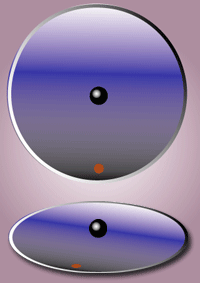Centrifugal force
[[File:Huygens_-_%C5%92uvres_compl%C3%A8tes,_Tome_7,_1897.djvu&page=353_325]_|Huygens - %C5%92uvres compl%C3%A8tes, Tome 7, 1897.djvu&page=353 325]|thumb|left]] [[File:Huygens_-_%C5%92uvres_compl%C3%A8tes,_Tome_7,_1897.djvu}}</ref>|Huygens - %C5%92uvres compl%C3%A8tes, Tome 7, 1897.djvu}}</ref>|thumb|left]]
Centrifugal force is a force that acts outward on a body moving around a center, arising from the body's inertia. It is a fictitious force or pseudo force that appears to act on all masses in a rotary motion, directed away from the center of rotation. This force is perceived in a rotating frame of reference and is not observed in a inertial frame of reference, where only the centripetal force is at play.
Overview[edit | edit source]
In the context of circular motion, when an object moves in a circle and maintains a constant speed, it is subject to an acceleration directed towards the center of the circle. This acceleration is provided by the centripetal force. However, from the perspective of the object in rotation, it feels a force pushing it away from the center. This apparent force is what we term as centrifugal force. It is important to note that centrifugal force does not exist when describing the motion from an inertial frame of reference - it is a result of adopting a rotating reference frame.
Mathematical Description[edit | edit source]
The magnitude of the centrifugal force can be described by the formula: \[ F = m \omega^2 r \] where:
- \(F\) is the centrifugal force,
- \(m\) is the mass of the object experiencing the force,
- \(\omega\) is the angular velocity of the rotation, and
- \(r\) is the radius of the circle.
Applications and Misconceptions[edit | edit source]
Centrifugal force has practical applications in various fields, including astronautics, where it is used in designing artificial gravity systems for spacecraft, and in centrifuges where it is utilized to separate substances of different densities. However, the concept of centrifugal force is often misunderstood and incorrectly applied, leading to misconceptions in physics education and everyday understanding.
Centrifugal vs. Centripetal Force[edit | edit source]
It is crucial to distinguish between centrifugal force and centripetal force. Centripetal force is the real force that acts on an object moving in a circular path and is directed towards the center of rotation, keeping the object in motion. In contrast, centrifugal force is an apparent force that acts outwardly away from the center of rotation and is observed only in a rotating reference frame.
See Also[edit | edit source]
Search WikiMD
Ad.Tired of being Overweight? Try W8MD's physician weight loss program.
Semaglutide (Ozempic / Wegovy and Tirzepatide (Mounjaro / Zepbound) available.
Advertise on WikiMD
|
WikiMD's Wellness Encyclopedia |
| Let Food Be Thy Medicine Medicine Thy Food - Hippocrates |
Translate this page: - East Asian
中文,
日本,
한국어,
South Asian
हिन्दी,
தமிழ்,
తెలుగు,
Urdu,
ಕನ್ನಡ,
Southeast Asian
Indonesian,
Vietnamese,
Thai,
မြန်မာဘာသာ,
বাংলা
European
español,
Deutsch,
français,
Greek,
português do Brasil,
polski,
română,
русский,
Nederlands,
norsk,
svenska,
suomi,
Italian
Middle Eastern & African
عربى,
Turkish,
Persian,
Hebrew,
Afrikaans,
isiZulu,
Kiswahili,
Other
Bulgarian,
Hungarian,
Czech,
Swedish,
മലയാളം,
मराठी,
ਪੰਜਾਬੀ,
ગુજરાતી,
Portuguese,
Ukrainian
Medical Disclaimer: WikiMD is not a substitute for professional medical advice. The information on WikiMD is provided as an information resource only, may be incorrect, outdated or misleading, and is not to be used or relied on for any diagnostic or treatment purposes. Please consult your health care provider before making any healthcare decisions or for guidance about a specific medical condition. WikiMD expressly disclaims responsibility, and shall have no liability, for any damages, loss, injury, or liability whatsoever suffered as a result of your reliance on the information contained in this site. By visiting this site you agree to the foregoing terms and conditions, which may from time to time be changed or supplemented by WikiMD. If you do not agree to the foregoing terms and conditions, you should not enter or use this site. See full disclaimer.
Credits:Most images are courtesy of Wikimedia commons, and templates, categories Wikipedia, licensed under CC BY SA or similar.
Contributors: Prab R. Tumpati, MD



